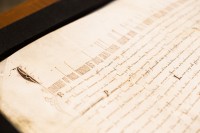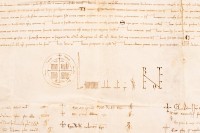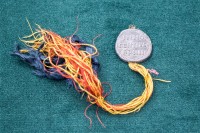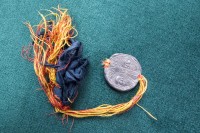 The University of British Columbia Library has acquired what may be the oldest document of its kind in Canada: a Papal bull issued by Pope Innocent IV in 1245. The ink on parchment manuscript was signed by the Pope and 13 cardinals, among them Giovanni Gaetano Orsini, recently appointed Cardinal-Deacon of the titular church of St. Nicola in Carcere and future Pope Nicholas III. Accompanying the parchment is the lead seal (bulla in Latin, which gives the decree its name) at the end of a tassel of blue ribbon and red and yellow silk cords. It’s no longer attached to the document, but it’s otherwise in excellent condition.
The University of British Columbia Library has acquired what may be the oldest document of its kind in Canada: a Papal bull issued by Pope Innocent IV in 1245. The ink on parchment manuscript was signed by the Pope and 13 cardinals, among them Giovanni Gaetano Orsini, recently appointed Cardinal-Deacon of the titular church of St. Nicola in Carcere and future Pope Nicholas III. Accompanying the parchment is the lead seal (bulla in Latin, which gives the decree its name) at the end of a tassel of blue ribbon and red and yellow silk cords. It’s no longer attached to the document, but it’s otherwise in excellent condition.
The bull is a beautiful document. It’s 2 by 1.8 feet in dimension and penned in a glorious hand on sheepskin or calfskin parchment.
Highlights include the first line, which boasts elongated letters referred to as litterae elongatae. Meanwhile, a circular Papal monogram called a rota (Latin for “wheel”) features a cross – likely penned by the Pope himself. Every sentence ends in a particular rhythmical cadence called cursus, similar in effect to a poem.


It was purchased last year from London antiquarian bookseller Bernard Quaritch Ltd. for $15,000 to strengthen the library’s collection of medieval manuscripts. These documents are invaluable teaching tools for the university’s English and History departments because, in addition to the information they contain, they give the students a tangible connection to the past they’re studying. Although it was in good condition when it arrived, the bull
had been stored in a folded fashion for centuries. As a result, it featured numerous thick creases that caused small gaps and tears.
Anne Lama, conservator at the library, previously spent a decade working at the National Archives in Paris. To address the creases, she placed the document in a humidification chamber, a rectangular structure with a Plexiglas lid that regulates moisture in order to “relax” the bull and soften its stubborn creases. “The document is like a patient,” explains Lama. “Restoration is like medicine.”
She also undertook other efforts, which included dusting, gap-filling, and drying and flattening the bull. The result is a gorgeous, golden-hued specimen. “I’m completely happy,” says Lama. “Now we can read the document without damaging it.”
You can see the difference by comparing the photographs in this post to the digitized version of the document.
 The First Council of Lyons was the least attended church council yet with 150 bishops, but that sparse attendance was actually a ramification of how politically significant it was. Pope Innocent IV was on the run from Holy Roman Emperor Frederick II, stupor mundi, whose troops were besieging Rome. He escaped through Liguria reaching Lyons, which was conveniently located just outside of Frederick’s territory, in December of 1244 and in the beginning of the new year called an ecumenical council for June. Although Frederick sent three representatives of his own, many of the prelates from his German and Sicilian territories were too intimidated to attend. Turmoil in the east kept many others away. In the end attendants were primarily from France and Spain.
The First Council of Lyons was the least attended church council yet with 150 bishops, but that sparse attendance was actually a ramification of how politically significant it was. Pope Innocent IV was on the run from Holy Roman Emperor Frederick II, stupor mundi, whose troops were besieging Rome. He escaped through Liguria reaching Lyons, which was conveniently located just outside of Frederick’s territory, in December of 1244 and in the beginning of the new year called an ecumenical council for June. Although Frederick sent three representatives of his own, many of the prelates from his German and Sicilian territories were too intimidated to attend. Turmoil in the east kept many others away. In the end attendants were primarily from France and Spain.
On the agenda at this council was the dignity of the Church (the rule that cardinals had to wear red hats was first promulgated at Lyons), reconquest of the Holy Land, dealing with the Mongol Empire’s invasions of eastern and central Europe, and last but most certainly not least, addressing the conflict between papacy and empire. On July 17th, the council issued the bull Ad Apostolicae Dignitatis Apicem which excommunicated and deposed Emperor Frederick II on the grounds that he’d broken oaths he made to the Church, forcibly detained delegates on their way to an earlier council and was probably a heretic anyway, complete with a harem, eunuchs and Saracen guards.
 The bull at the UBC Library was issued on July 30th, three days after the pope excommunicated and deposed the Holy Roman Emperor. It confirmed the benefices and properties of the Poor Clares in the church of Saint Michael in Trento, placing them under the direct protection of the Holy See. As minor an issue as this may seem compared to the excommunication of an emperor, it was all part of the rich tapestry of flipping Frederick the bird.
The bull at the UBC Library was issued on July 30th, three days after the pope excommunicated and deposed the Holy Roman Emperor. It confirmed the benefices and properties of the Poor Clares in the church of Saint Michael in Trento, placing them under the direct protection of the Holy See. As minor an issue as this may seem compared to the excommunication of an emperor, it was all part of the rich tapestry of flipping Frederick the bird.
In 1027 Holy Roman Emperor Conrad II had established the Bishopric of Trent, an area roughly equivalent to the modern autonomous region of Trentino, as an ecclesiastical principality. Conrad deemed bishops less likely to cause trouble than German princes and Trentino was strategically important because two transalpine Roman roads connecting what is today southern Germany to northern Italy crossed through it. The Bishops were strong allies of the Emperor against local lords for two centuries. In 1236, Frederick II deposed the bishops and reclaimed direct imperial authority over Trento, appointing his personal friend Ezzelino III da Romano as viceroy.
Meanwhile, Abbess Palmeria of the Poor Clares had received the church of Saint Michael in Trento and its associated benefices from Bishop Gerald Oscasali in 1229. In 1237, the year after Frederick deposed the Bishop of Trent, Pope Gregory IX wrote to the secular authorities in Trento to complain about them harassing the sisters and levying taxes on donations to the convent. By placing the Saint Michael convent under the protection of the Holy See, the 1245 Papal bull was drawing yet another line in the sand between Church and State: this is ours and your laws/taxes/claims don’t apply.
As an aside, the question of donations was a thorny one from a religious perspective as well, since whether the Poor Clares could own property was a raging debate. Clare herself was still alive and not yet a saint when all this was going down. There was no Rule yet. The Clares lived according to strictures drawn up by Gregory when he was bishop. Innocent IV’s bull asserted their right to financial self-sufficiency, to possessions, one of a series of similar decisions from a number of popes that would materially alter the original brief of the mendicant orders.